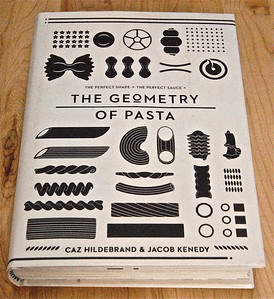
Last week I looked at an older, beloved cookbook, “How to Eat.” This week I explore what seems destined to become a new favorite. Co-created by critically acclaimed chef Jacob Kenedy and graphic designer Caz Hildebrand, “The Geometry of Pasta” (Quirk Books, 2010) delves into the history of pasta shapes and what sauces compliment each shape. Curious about why fusilli looks like a corkscrew or what sauce goes well with that cute, pinwheel-shaped pasta? Through black and white drawings by Hildebrand and over 100 recipes by Kenedy I’ve learned those answers – and more – in this engaging cookbook.
Although I’ve yet to cook my way through all of “The Geometry of Pasta,” I have found quite a few culinary gems. Take, for instance, orecchiette con cime i rappa or orecchiette broccoli rabe. Featuring sliced garlic, crushed red pepper flakes, broccoli rabe and, of course, “little ears” of orecchiette, this light, olive oil-dressed dish works perfectly as a generous meal for two or side for four to six.
Spaghetti alla puttanesca likewise won me over in a bite. Seriously, how could I not love a dish that includes some of my favorite ingredients – cherry tomatoes, capers, black olives – and possesses the intriguing nickname of “whore’s pasta?” While I never learned exactly who inspired that moniker, I did find out that puttanesca sauce goes well with a variety of pastas, including bucatini, farfalle, fusilli, linguine and rigatoni.
Along with savory sauces this book provides steps for making my own agnolotti, cavatelli, gnocchi and orecchiette. These effortless recipes don’t even require me to dust off my neglected pasta maker. Just mix, roll, cut, and boil. Easy!
Simplicity is one of the many things that I appreciate about “The Geometry of Pasta.” Thanks to Kenedy’s well-considered recipes, I won’t spend hours shopping for the nightly meal. Using a handful of everyday ingredients, I can create a spectacular Italian dinner without a lot of fuss. My family and friends may think that I’ve slaved away all day but, luckily, that won’t be the case.
What I admire most about this book are its rich histories, illuminating graphics, and helpful tips. Never again will I wonder how a pasta got its name, why it has a certain shape or what one pairs best with a specific sauce. Everything that I’ll ever need to know about “The Geometry of Pasta” is contained here.